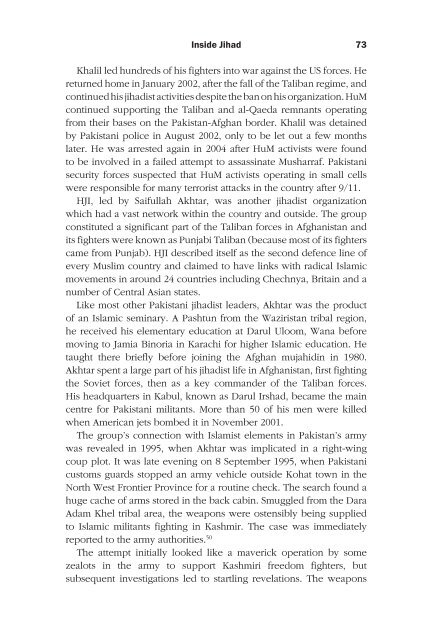Frontline Pakistan : The Struggle With Militant Islam - Arz-e-Pak
Frontline Pakistan : The Struggle With Militant Islam - Arz-e-Pak
Frontline Pakistan : The Struggle With Militant Islam - Arz-e-Pak
You also want an ePaper? Increase the reach of your titles
YUMPU automatically turns print PDFs into web optimized ePapers that Google loves.
Inside Jihad<br />
Khalil led hundreds of his fighters into war against the US forces. He<br />
returned home in January 2002, after the fall of the Taliban regime, and<br />
continued his jihadist activities despite the ban on his organization. HuM<br />
continued supporting the Taliban and al-Qaeda remnants operating<br />
from their bases on the <strong><strong>Pak</strong>istan</strong>-Afghan border. Khalil was detained<br />
by <strong><strong>Pak</strong>istan</strong>i police in August 2002, only to be let out a few months<br />
later. He was arrested again in 2004 after HuM activists were found<br />
to be involved in a failed attempt to assassinate Musharraf. <strong><strong>Pak</strong>istan</strong>i<br />
security forces suspected that HuM activists operating in small cells<br />
were responsible for many terrorist attacks in the country after 9/11.<br />
HJI, led by Saifullah Akhtar, was another jihadist organization<br />
which had a vast network within the country and outside. <strong>The</strong> group<br />
constituted a significant part of the Taliban forces in Afghanistan and<br />
its fighters were known as Punjabi Taliban (because most of its fighters<br />
came from Punjab). HJI described itself as the second defence line of<br />
every Muslim country and claimed to have links with radical <strong>Islam</strong>ic<br />
movements in around 24 countries including Chechnya, Britain and a<br />
number of Central Asian states.<br />
Like most other <strong><strong>Pak</strong>istan</strong>i jihadist leaders, Akhtar was the product<br />
of an <strong>Islam</strong>ic seminary. A Pashtun from the Waziristan tribal region,<br />
he received his elementary education at Darul Uloom, Wana before<br />
moving to Jamia Binoria in Karachi for higher <strong>Islam</strong>ic education. He<br />
taught there briefly before joining the Afghan mujahidin in 1980.<br />
Akhtar spent a large part of his jihadist life in Afghanistan, first fighting<br />
the Soviet forces, then as a key commander of the Taliban forces.<br />
His headquarters in Kabul, known as Darul Irshad, became the main<br />
centre for <strong><strong>Pak</strong>istan</strong>i militants. More than 50 of his men were killed<br />
when American jets bombed it in November 2001.<br />
<strong>The</strong> group’s connection with <strong>Islam</strong>ist elements in <strong><strong>Pak</strong>istan</strong>’s army<br />
was revealed in 1995, when Akhtar was implicated in a right-wing<br />
coup plot. It was late evening on 8 September 1995, when <strong><strong>Pak</strong>istan</strong>i<br />
customs guards stopped an army vehicle outside Kohat town in the<br />
North West Frontier Province for a routine check. <strong>The</strong> search found a<br />
huge cache of arms stored in the back cabin. Smuggled from the Dara<br />
Adam Khel tribal area, the weapons were ostensibly being supplied<br />
to <strong>Islam</strong>ic militants fighting in Kashmir. <strong>The</strong> case was immediately<br />
reported to the army authorities. 50<br />
<strong>The</strong> attempt initially looked like a maverick operation by some<br />
zealots in the army to support Kashmiri freedom fighters, but<br />
subsequent investigations led to startling revelations. <strong>The</strong> weapons













